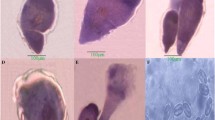Abstract
The development of resting spores in 2 Synchytrium species namely Synchytrium lagenariae Mhatre and Mundkur and S. trichosanthidis Mhatre and Mundkur parasitic on cucurbitaceous hosts has been studied. Both the species have a similar pattern of development and do not exhibit gross variation in their sequence and mode of development.
Similar content being viewed by others
References
Bally, W. 1912. Cytologische Studien an Chytridineen. Jahrb. Wiss. Botan. 50: 95–156.
Curtis, K.M. 1921. The life-history and cytology of Synchytrium endobioticum (Schilb.) Perc., the cause of wart disease in potato. Phil. Trans. Roy. Soc. B 210: 409–478.
Gupta, S.C. & S. Sinha. 1951. Further additions to the Synchytria of India. Indian Phytopath. 4: 7–10.
Gupta, S.C. & S. Sinha. 1951. Two new species of Synchytrium. Indian Phytopath. 8: 78.
Johansen, D.A. 1940. Plant microtechnique. McGraw Hill Book Co. Inc., New York. 523 p.
Johnson, T. 1909. Chrysophlyctis endobiotica Schilb. (Potato-wart or Black scab), and other Chytridiaceae. Sci. Proc. Roy. Dublin Soc. 12: 131–144.
Karling, J.S. 1954. Synchytrium brownii, a new species with sexual reproduction. Sydowia, Ann. Mycol. 8: 27–30.
Karling, J.S. 1956. Development of Synchytrium innominatum in relation to other similar species. Mycologia 48: 534–536.
Karling, J.S. 1964. Synchytrium. Academic Press Inc., New York. 470 p.
Köhler, E. 1930. Beobachtungen an Zoosporen Aufschwemmungen von Synchytrium endobioticum (Schilb.) Perc. Zentr. Bakteriol. Parasitenk. Abs. II. 82: 1–10.
Köhler, E. 1956. Zur Kenntnis der Sexualität bei Synchytrium. Ber. deut. Botan. Ges. 69: 121–127.
Kusano, S. 1928. The relative sexuality in Synchytrium. Proc. Imp. Acad. Tokyo 4: 497–499.
Kusano, S. 1930. The life history and physiology of Synchytrium fulgens Schroet. with special reference to its sexuality. Japan J. Botany 5: 35–132.
Lingappa, B.T. 1958. The cytology of development and germination of resting spores of Synchytrium brownii. Am. J. Botany 45: 613–620.
Lingappa, B.T. 1958 a. Sexuality in Synchytrium brownii Karling. Mycologia 50: 524–537.
Mhatre, J.R. & B.B. Mundkur. 1945. The Synchytria of India. Lloydia 8: 131–138.
Percival, J. 1910. Potato ‘wart’ disease: the life history and cytology of Synchytrium endobioticum (Schilb.) Perc. Centr. Bakteriol. Parasitenk. Abt. II. 25: 440–447.
Raghavendra Rao, N.N. & M.S. Pavgi. 197-. Resting spore germination in Synchytrium species parasitic on Cucurbitaceae. Mycopathologia 69: 3–10.
Sass, J.E. 1967. Botanical microtechnique. Oxford & IBH Publg. Co., New Delhi. 228 p.
Author information
Authors and Affiliations
Rights and permissions
About this article
Cite this article
Raghavendra Rao, N.N., Pavgi, M.S. Development of resting spores in two Synchytrium species parasitic on cucurbitaceae. Mycopathologia 71, 145–148 (1980). https://doi.org/10.1007/BF00473061
Issue Date:
DOI: https://doi.org/10.1007/BF00473061




